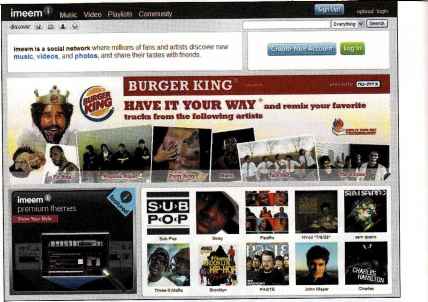Creating or Participating in Online Social Networks
Online social communities—blogs, social networking Web sites, or even virtual worlds—where people socialize or exchange information and opinions.
The popularity of the Internet has resulted in a rash of online social networks or Web communities. Countless independent and commercial Web sites have arisen that give consumers online places to congregate, socialize, and exchange views and information. These days, it seems, almost everyone is buddying up on MySpace or Facebook, tuning into the day's hottest videos at YouTube, or even living a surprisingly real fantasy life as an avatar on Second Life. And, of course, wherever consumers congregate, marketers will surely follow. More and more marketers are now starting to ride the huge social networking wave.
Marketers can engage in online communities in two ways: They can participate in existing Web communities or they can set up their own. Joining existing networks seems easiest. Thus, many major brands—from Burger King, Honda, and Motorola to Estee Lauder and Victoria's Secret—have set up MySpace pages and profiles. Burger King, for instance, has amassed more than 120,000 MySpace "friends," fellow users who have chosen to associate themselves with this profile.
Targeting Niches of Like-Minded People
Marketers who think bigger is better may want to reconsider, at least when it comes to online social networks. Although giant networks such as MySpace and Facebook get all the attention these days, social networks focused on topics as remote as knitting or bird watching can present marketers with strong targeting opportunities:
When jet-setters began flocking to an exclusive social-networking Web site reserved for the rich, they got the attention of an online community's most valuable ally: advertisers. The invitation-only site, ASmallWorld.net, has 300,000 select members who have become a magnet for companies that make luxury goods and are trying to reach people who can afford them. The site's biggest advertisers include Burberry, Cartier, and Land Rover. Cognac maker Remy Martin last month threw a tasting party for the site's elite members, at which its top-shelf, $1,800-a-bottle liquor flowed freely.
Thousands of social-networking sites have popped up to cater to specific interests, backgrounds, professions, and age groups. Nightclub frequenters can converge at DontStayln.com. Wine connoisseurs have formed Snooth.com, and people going through divorce can commiserate at Divorce360.com.
When it comes to marketing through online social-networking sites, smaller might be better. Niche site imeem.com works with sponsors such as Burger King, which target its younger and edgier membership community. "Relevance trumps size," says one expert.

More and more, marketers are taking a chance on smaller sites that could be more relevant to their products. AT&T, for example, recently promoted one of its global cell phones on WAYN.com (short for "Where are you now?"), a social network for international travelers. While
AT&T advertises on the bigger sites like MySpace to reach a large audience quickly, the wireless carrier is also turning to niche networks, "where your ads are more meaningful—those are the real gems," says a social networking expert.
There's at least one social network for just about every interest or hobby. Yub.com is for shopoholics, Fuzzster.com is for pet lovers, OnLoq.com is for hip-hop fans, Jango.com lets music fans find others with similar tastes, and PassportStamp.com is one of several sites for avid travelers.
500,000 members. And companies by the dozens are now hanging up virtual shingles in Second Life—from Nike and Coca-Cola to Dell, Toyota, IBM, l-8OO-FLOWERS.COM, and the tax-preparation company H&R Block.
Although the large online social networks such as MySpace and Facebook have grabbed most of the headlines, a new breed of more focused niche networks has recently emerged. These more focused networks cater to the needs of smaller communities of like-minded people, making them ideal vehicles for marketers who want to target special interest groups.
But participating successfully in existing online social networks presents challenges. First, online social networks are new and results are hard to measure. Most companies are still experimenting with how to use them effectively. Second, such Web communities are largely user controlled. The company's goal is to make the brand a part of consumers' conversations and their lives. However, marketers can't simply muscle their way into consumers' online interactions—they need to earn the right to be there. "You're talking about conversations between groups of friends," says one analyst. "And in those conversations a brand has no right to be there, unless the conversation is already about that brand." Says another expert, "Being force-fed irrelevant content, or feeling tricked into taking in a brand,
Some cater to the obscure. Passions Network, with 600,000 members, has 106 groups for specific interests, including "Star Trek" fans, truckers, atheists, and people who are shy. The most popular group is a dating site for the overweight. Membership on niche networking sites varies greatly, ranging from a few hundred to a few million. LinkExpats.com, which provides an online haven for expatriates, launched last month and has about 200 members. Flixster.com has 40 million members who rate movies and gossip about actors.
According to e-marketer, by 2011, half of all adults in the United States, for example, and 84 percent of online teens will use social networks. A running tally of emerging social networks, now upward of 7,000 by one estimate, suggests an explosive market. That's both a golden opportunity and a colossal headache for brands trying to nail down the best new network for their campaigns.
Although the niche sites have many fewer members than mega-sites such as MySpace (more than 110 million active profiles) and Facebook (59 million), they contain dedicated communities of like-minded people. And as on the bigger networks, members can build personalized pages and use them to share information, photos, and news with friends. That makes the niche sites ideal vehicles for marketers who want to target special interest groups.
The niche sites often provide a better marketing message environment. "Because members of niche social networks share
common interests and experiences, they tend to spend more time on the site and contribute to the group by chatting and posting comments," notes an online consultant. On bigger sites, "members tend to be less involved ... and are therefore less appealing to advertisers." Also, "the bigger sites have become so cluttered and overrun with advertisers that members are used to tuning stuff out, even personalized ads. ... But on networking sites that have a self-selecting demographic, people tend to trust the content, including ads."
Not all niche networks welcome marketers. Sermo.com—a social-networking site at which some 65,000 licensed physicians consult with colleagues specializing in areas ranging from dermatology to psychiatry-allows no marketing. However, for a fee, companies can gain access to Sermo.com data and member discussions. "They can monitor online discussions, with the doctors' names omitted, or see a tally of topics being discussed at the site to determine what's rising or falling in popularity," notes a health care industry analyst.
Still, most of the niche sites offer unique campaign opportunities to brands. Sites like imeem.com—a social network where "fans and artists discover new music, videos, and photos, and share their tastes with friends"—are carving out their niches and actively soliciting advertising dollars. "We tend to skew younger and edgier," with a demographic of 13-24, says imeem's chief marketer. An ever-growing niche of more than 100 million users interact with imeem, helping it to attract big-name sponsors such as Burger King, Scion, Nokia, and T-Mobile, which sponsor special features and events. For example, one promotion involved artist J. Holiday texting his thoughts on tour to imeem.com members through his T-Mobile sidekick cell phone.
The more focused audiences offered by such niche networks are increasingly popular with brands because "relevance," says the consultant, "trumps size." But how brands execute social-networking campaigns is as important as where they do it. Marketers must be careful not to become too commercial or too intrusive. Keeping sites hip and unencumbered by advertising is a balancing act for both the brands and the social networks. The best approach is not to market to network members but to interact with them on topics of mutual interest. Says one online marketer, "The real way of getting into social media is you don't advertise, you participate in the community."
Sources: Portions adapted from Betsey Cummings, "Why Marketers Love Small Social Networks," Brandweek, April 27, 2008, accessed at www.brandweek.com; with adapted extracts, quotes, and other information from Kim Hart, "Online Networking Goes Small, and Sponsors Follow," Washington Post, December 29, 2007; p. D1; and Jessica E. Vascellaro, "Social Networking Goes Professional," Wall Street Journal, August 28, 2007, p. D1. Also see Heather Green, "Arts and Crafts Find New Life Online," BusinessWeek, January 14, 2008, pp. 60-61; and Paula Lehman, "Social Networks That Break a Sweat," BusinessWeek, February 4, 2008, p. 68. is a major turn-off." Rather than intruding, marketers must learn to become a valued part of the online experience.
When it comes to online networks, it's not enough just to be there. For example, when Toyota's Scion first opened a Second Life showroom last year, it quickly became a top destination. But only a few months later, Second Life residents had largely deserted the showroom. Toyota's mistake? It failed to understand that driving adds little value in a virtual world where Second Life avatars can walk underwater, fly, and "beam" themselves around. Instead, as in any other marketing endeavor, companies participating in Web communities must learn how to add value for consumers in order to capture value in return.
To avoid the mysteries and challenges of building a presence on existing online social networks, many companies are now launching their own targeted Web communities. For example, Coca-Cola has developed a Sprite Yard cell phone network—available to Web-ready phones—where members can set up profiles, post pictures, and meet new friends. On Nike's Nike Plus Web site, some 200,000 runners upload, track, and compare their performances. More than half visit the site as least four times a week, and Nike plans eventually to have 15 percent or more of the world's 100 million runners actively participating in the Nike Plus online community.
Continue reading here: Irritation Unfairness Deception and Fraud
Was this article helpful?


